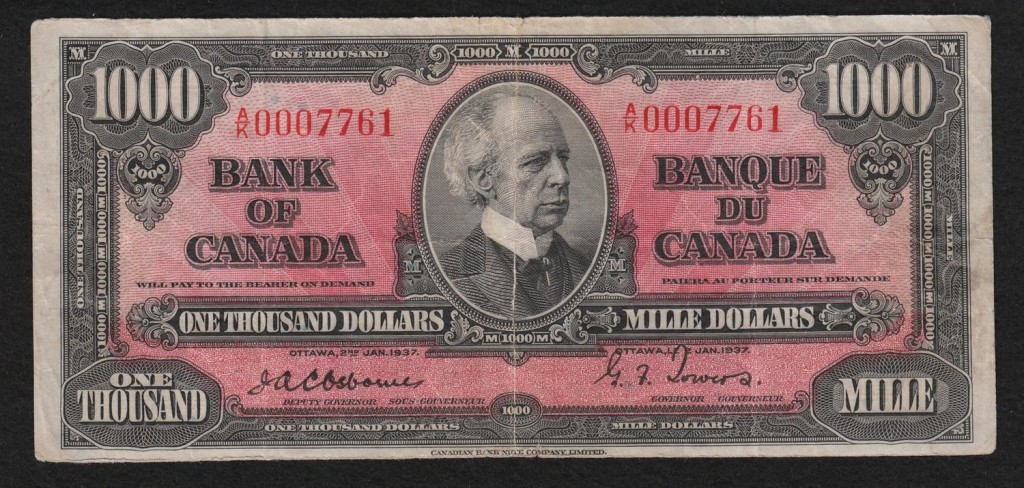
Canadian Thousand Dollar Bills are some of the greatest examples of Canadian currency ever issued. Though discontinued in the 2000s, Canadian Thousand Dollar Bills are highly prized by collectors and are worth a lot of money, especially the old Dominion of Canada examples.
For the more modest collectors, however, you can pick up an authentic Canadian $1000 Bill for under $1500 depending on condition of course.
From the first appearance of the denomination in 1871 until its removal from circulation in May of 2000, the iconic one thousand dollar bill will always hold a special place in the history of Canadian currency.
I’ve always wanted to own one in my collection, but sadly I didn’t want to part with the money! Instead, I offer this tribute to that legendary denomination.
1871 Dominion of Canada Thousand Dollar Bill
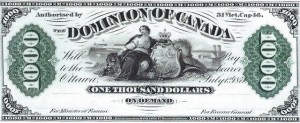
In 1871, the Dominion of Canada issued its first one thousand dollar bill. At the time, the average person’s daily cash transactions rarely ever exceeded 1 dollar. Consequently, the one thousand dollar bills seldom saw any public circulation. In fact they were primarily held by chartered banks as a security, that could be exchanged for gold and that backed their own bank notes in circulation.
The front of the bank note depicts the coat of arms of the Dominion of Canada flanked by a lion and a woman. The interesting thing about these early Dominion of Canada bank notes is that on the back side they were stamped “Payable” at a particular city. Seven different varieties of the one thousand dollar notes were issued. They were payable at Toronto, Montreal, St. John, Halifax, Victoria, Winnipeg and Charlottetown.
These bank notes are extremely rare. I’ve only ever seen one at the national currency museum. The Charlton guide on Canadian paper money reports that this is the only one that exists. The exact quantity of 1871 thousand dollar bills produced is unknown. We do have information about the varieties that were payable in Winnipeg and Charlottetown as they were printed and issued later, in 1891 and 1892. The numbers printed were 420 and 150 respectively. If these numbers offer any indication, it’s likely that production numbers never ran more than a few hundred examples for each variety.
Bank Legals 1896-1924
Bank Legals were large denomination notes that were not issued for public circulation. In fact, rather than being payable to the bearer, they were only payable to other banks as specified in the Bank Act. These notes served a specific function in the early Canadian banking system.
They were held by banks as a reserve, sometimes in addition to or in lieu of gold, to back their own bank notes in circulation. They were also used as a means of exchange between banks to settle outstanding balances that were owed to each other. Nonetheless, these notes are still quite impressive examples of early Canadian currency. Surviving examples of these notes are limited to specimens and face and back proofs.
1896 Dominion of Canada Thousand Dollar Bill
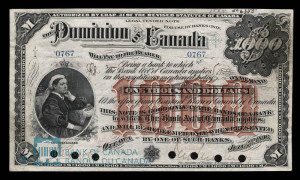
The 1896 note features Queen Victoria while the 1901 and 1924 notes feature Lord Roberts.
1901 Dominion of Canada Thousand Dollar Bill
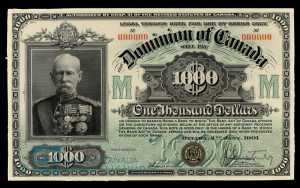
1924 Dominion of Canada Thousand Dollar Bill
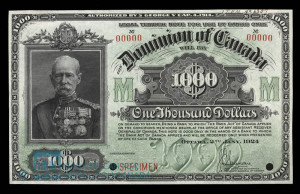
1911 Dominion of Canada Thousand Dollar Bill
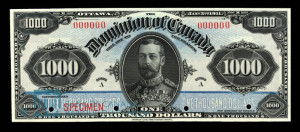
After 40 years of circulation among financial institutions, the supply of one thousand dollar bank notes was depleted. There arose a need to once again produce one thousand dollar bills. The front features King George V and from 1911-1924 a total of 34,000 were produced and issued as needed. Before they were issued, however, they were hand signed.
In contrast to the Bank Legals, these notes were payable to the Bearer so they could be used in general circulation. Few of these notes exist outside institutional collections and at auction they can sell for $100,000.
1925 Dominion of Canada Thousand Dollar Bill
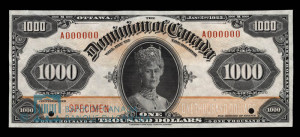
According to Charlton, in early 1925 there were difficulties with the circulation of the 1911 one thousand dollar bank notes. The Department of Finance decided to produce new one thousand dollar bills and quickly remove the older 1911’s from circulation. An order for 30,000 new one thousand dollar bank notes was placed and, as had been the case with earlier runs of the bills, they were hand signed and issued as needed.
The front of the 1925 one thousand dollar bill features Queen Mary. These notes are also quite rare and, in higher grades, can fetch nearly $100,000 at auction.
1935 Thousand Dollar Bill English Variety
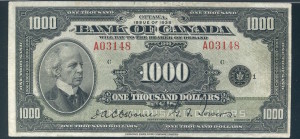
Soon after its creation in 1934, the Bank of Canada began to issue its own bank notes. The 1935 one thousand dollar bill features Sir Wilfred Laurier on the front. What makes this issue unique is that two separate versions of each denomination were produced, one in English and the other in French.
1935 Thousand Dollar Bill French Variety
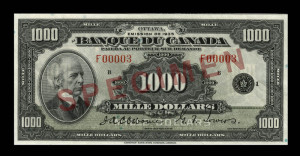
Fewer French notes were produced (approx. 7,500 compared to nearly 67k English notes) and are consequently much more difficult to find than their English counterparts. High grade English versions can fetch up to $20k at auction, while comparable French versions can go for double that easily.
1937 Thousand Dollar Bill
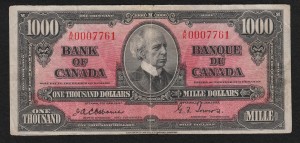
The death of King George V and abdication of Edward VIII resulted in the ascension of George VI to the throne in 1937. The Bank of Canada issued new circulation bank notes with the king’s portrait on all denominations except the $500 and $1,000. Although the 1937 one thousand dollar bills were printed in 1937, the 1935’s were still in circulation until 1952.
In similar fashion to the 1935 one thousand dollar bill, the 1937 one also features a portrait of Sir Wilfred Laurier on the front. What makes the 1937 issue unique is that it was the first bilingual bank note issued by the Bank of Canada. About 15,000 1937 one thousand dollar bills were printed but very few remain today. Uncirculated varieties can fetch nearly $20k at auction.
1954 Thousand Dollar Bill
Following the death of King George VI in 1952, the Bank of Canada released a new set of bilingual bank notes in 1954. All of the denominations feature the portrait of Queen Elizabeth II.
1954 Devil’s Face Thousand Dollar Bill
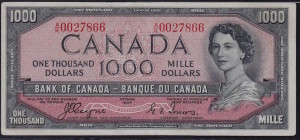
Early examples of the 1954 issue are of the so-called Devil’s Face variety that resulted from highlighting some areas of the Queen’s hair just behind her ear. The combination of highlighting and shading gave the appearance of a “devil’s face” peering out from behind her ear. This generated a lot of controversy at the time and lower denomination bank notes were quickly replaced with modified versions that shaded in the problematic area.
The majority of devil face notes were replaced by 1956, but the one thousand dollar notes weren’t modified until a few years later. This was probably due to their limited circulation. Approximately 30,000 devil face one thousand dollar bank notes were produced and surviving examples are highly prized by collectors due to their scarcity. They can fetch up to 20k at auction for higher end, uncirculated examples.
1954 Modified Thousand Dollar Bill
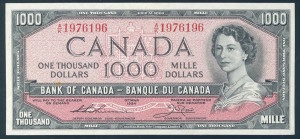
The modified 1954 thousand dollar bills were in use for over thirty years and have 5 different signature combinations. Among the scarcer signature combinations is the Beattie-Coyne which can sell for up to 10k at auctions.
1988 Bird Series Thousand Dollar Bill
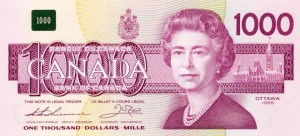
After skipping the $1000 denomination altogether in the release of a new set of bank notes for the 1970s, the Bank of Canada issued a new $1000 bill as part of its Bird Series of bank notes in the 1980s and early 1990s. The bank note features an updated portrait of Queen Elizabeth II on the front and a picture of a Pine Grosbeak on the back.
Millions of these bank notes were produced, including nearly 350k replacement notes that have an EKX prefix. Typical uncirculated examples of this series sell for around $2,000, while the replacement EKX can fetch about a thousand dollars more.
These notes were pulled from circulation in 2000 as part of government efforts to combat organized crime and money laundering. In spite of those efforts, nearly 1 million notes are still circulating. It is widely believed that the vast majority of those circulate in the underground world of organized crime.
For more information about Canada’s paper currency check out the 2016 Charlton Canadian Government Paper Money 28th Edition
Thanks for reading Canadian Thousand Dollar Bills If you’ve enjoyed this article, check out my other coin articles: